The first time Janet Nelson visited Lake Bluff she didn’t see much of it. This was in the early 1960s, and the birth of the Nelsons’ fourth child was putting a squeeze on their starter home in Northbrook. Janet had come across an ad for a development called The Terrace in Lake Bluff, and she was familiar with the developer, Chicago Construction Company, a powerhouse firm that had developed many suburban properties including her current house. But she’d never been to the village, so she decided to go for a drive with a friend to check out a spec house.
Janet and her friend didn’t find The Terrace on that visit. Instead, they wound up in front of a park (Artesian), driving up and down streets lined with narrow lots and old houses that looked, when you thought about it, like summer cottages from a bygone era. Where was the planned development with its brand new “Ranches, Colonials and Tri-Level single-family homes on quarter-acre wooded and improved lots” (per the ad) that was designed for the post-World War II Baby Boom generation? Where were the two-car garages, newly paved streets with freshly poured concrete gutters, and sidewalks? For that matter, where was Lake Bluff’s downtown?
The two drove around the southeast side of Lake Bluff, missing Scranton Avenue and the few shops that were there, before deciding they were nowhere near a new subdivision.
“We found a town,” Janet recalled. “It was a very little town, and not very noteworthy.”
She didn’t give up, as the Nelsons were motivated by two things that have driven real estate decisions for generations: good schools and affordability.
“Lake Bluff seemed then, and remains today, a very good place to raise a family,” said Janet in 2023.
On her next visit to the village, this time with her husband Herb, Janet found The Terrace, located west of Green Bay Road (who knew Lake Bluff extended in that direction?). The Nelsons chose the lot at 405 Park Lane and picked a model for a three-bedroom, two-story house. Their cost for both was around $20,000.
Thus began Janet’s more than 60-year run in Lake Bluff, where she and Herb raised Rick, Anne, Margaret and Jimmy. Herb was an electrical engineer with C.P. Clare & Co. of Chicago; publisher of Radio Amateur Callbook; a Ham radio operator (W9IGL); and for many years volunteered as an LFTV cameraman taping Village of Lake Bluff meetings. Janet started off volunteering in the public schools and with Scout troops before getting a job in the East School library, then classroom teacher, and eventually elementary school principal.
She also served the community in many volunteer roles, including as president of the Lake Forest High School Board of Education in the early 2000s, and as a member and later head of the Village of Lake Bluff’s Historic Preservation Commission.
Amidst everything, 41 years ago Janet co-founded Lake Bluff History Museum with Kathy O’Hara, then a history teacher at Lake Bluff Middle School and later the school’s principal. The notion of a museum grew out of their desire to include Lake Bluff’s history in the District 65 social studies curriculum.

Janet and Kathy didn’t know a lot about local history back then, as they were both relatively new to the village. “Everyone told us to talk to Elmer Vliet,” she recalled.
Vliet was Lake Bluff’s historian. He had been gathering, researching and archiving Lake Bluff stories and photos since the 1930s and had served the village and its schools in many volunteer leadership positions. When Janet and Kathy met him in 1980, he had been retired from his job as chairman of Abbott Laboratories since 1962.
Elmer invited the teachers to his house on Prospect Avenue, where he set up an ironing board for his slide projector and shared his collection of Lake Bluff slides and stories from the 1830s well into the 20th century. Janet and Kathy were mesmerized and knew their students would be too. Elmer was happy to connect with educators who wanted to continue his mission. He eventually donated his collection of slides and provided seed money for the organization.
“The best way for children to understand history is to understand the history of their own community,” Janet told a Chicago Tribune reporter in 1997.
The two educators made no little plans for their little museum. They furnished two classrooms on the upper floor of East School (which was then located at 121 E. Sheridan Place, since demolished) to showcase Elmer’s slide collection to students and community groups. One of the rooms housed a life-size partial replica of the interior of Lake Bluff’s first grocery store; a display of military uniforms worn by village residents; artifacts from the North Shore Line railroad; and photos from the late 19th century summer resort run by the Lake Bluff Camp Meeting Association.
The second room was outfitted to resemble a turn-of-the-20th-century Lake Bluff classroom, with old school desks, globes, class pictures since 1913, and a Victrola, “home ec” sewing machine, and stereopticon.
“We wanted to create an old-style classroom and have the students and community groups sit in the old desks, with the big old blackboard, to show them what a classroom looked like. But Elmer’s stories and slides about Lake Bluff were much more interesting than the setting,” Janet said.
Janet and Kathy called it the Vliet Center officially, but most people referred to the classrooms as “The Museum.”
Why was sharing Lake Bluff’s history important?
“Lake Bluff was always in the shadow of Lake Forest,” Janet recalled. “But Lake Bluff is a unique community with its own history. It was founded by Methodists for middle-class vacationers, and it was not as socially restrictive as other towns. It wasn’t a typical North Shore community, and people need to know that.”
In 1995 the school district reclaimed the classroom space, prompting “The Museum” to look for a new home. Janet and Kathy moved the collection to a storefront on Scranton Avenue, and the Vliet Center for Lake Bluff History became a 501 (c) (3) organization with directors and bylaws. A few years later a public/private partnership consisting of the Village of Lake Bluff, Lake Bluff Public Library and the Vliet organization was formed. It raised more than $1 million to build an addition to the library for the Vliet Center.
Funds came from state and local grants plus generous contributions from residents. “It was as if we turned an umbrella upside down and the money flowed in,” Janet recalled board member Phyllis Albrecht saying at the time. The Vliet Center opened in 2002.
As the museum heads into its 41st year, Janet said she feels it is in a good place. It has grown to be “much more than a museum,” as the organization continues to share the village’s stories through displays, programs and events; collect and archive the community’s history; and facilitate research and information sharing.
Lake Bluff was a friendly place in the early 1960s, and it’s still a friendly place in 2023, Janet said.

